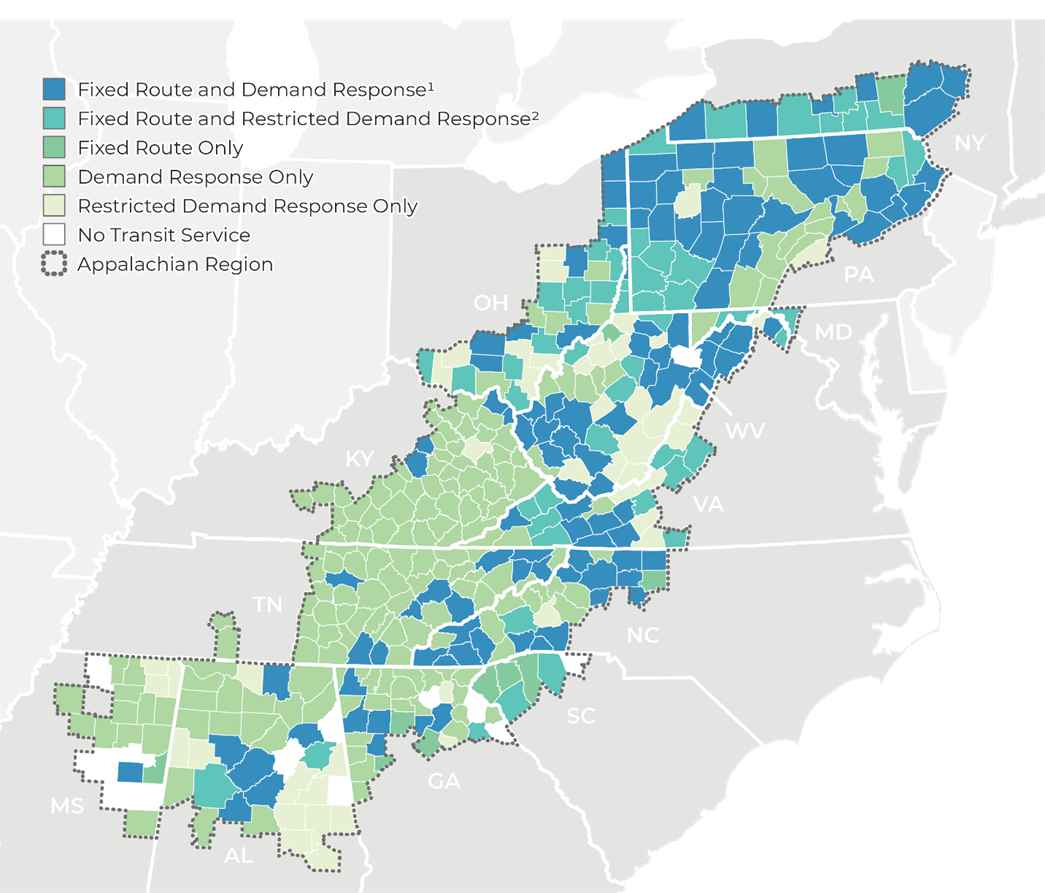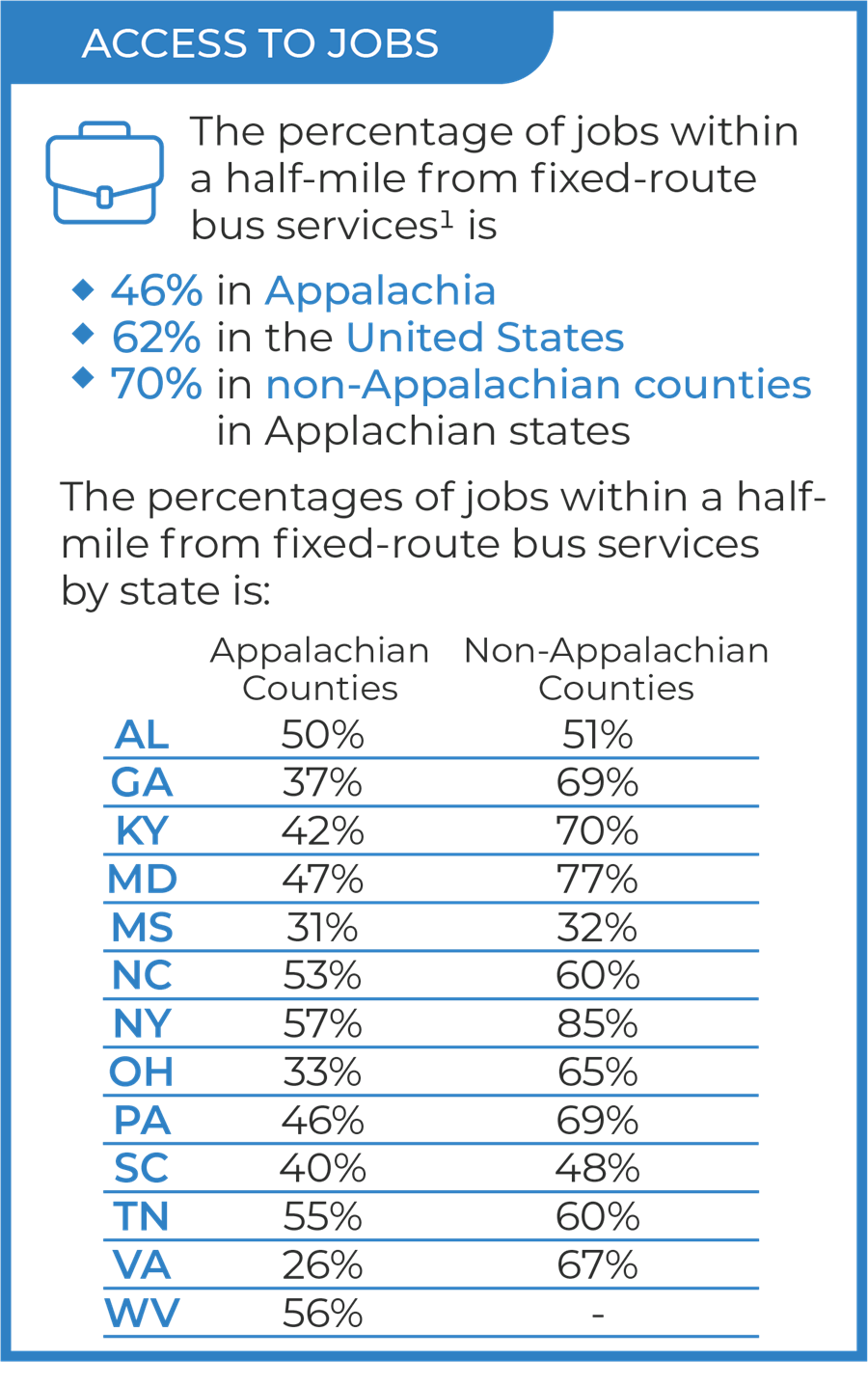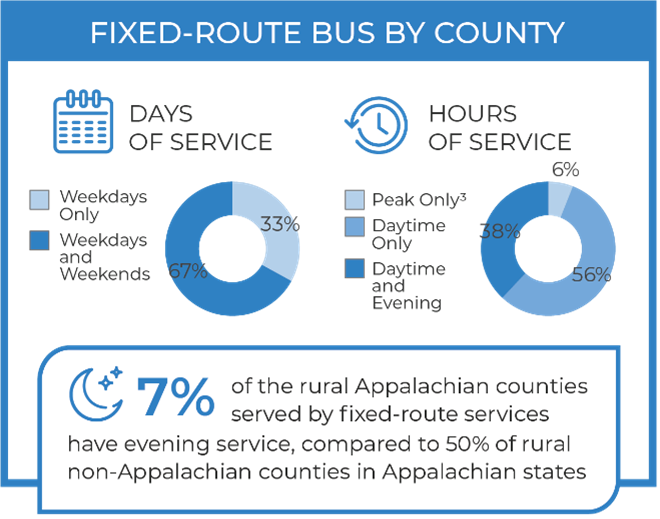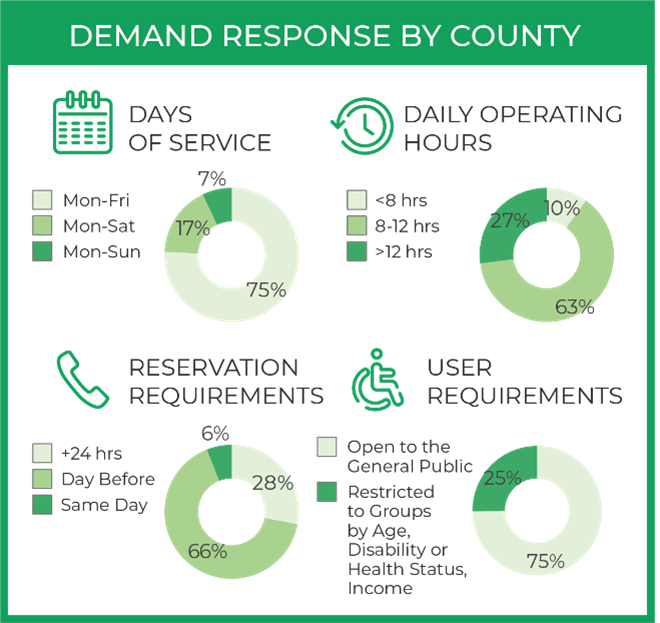After completing our Public Transportation in Appalachia project last year, we presented the findings at recent conferences to share best practices and challenges and to ensure rural and Appalachian agencies are aware of the resources available to them. In November, Shana Johnson presented at the Transportation Research Board (TRB) National Conference on Rural Public and Intercity Bus Transportation Conference, and Reinaldo Germano presented at the Transportation Association of Alabama and ALTRANS Fall Meeting.
Report and Fact Sheets
The full report, as well as fact sheets that summarize key findings for the Appalachian Region and all 13 Appalachian states, can be accessed at: https://www.arc.gov/report/public-transportation-in-appalachia/.
The report provides:
- A comprehensive database of fixed-route transit services using collected or created General Transit Feed Specification (GTFS) feeds.
- An in-depth analysis of access to fixed-route transit service, service provision, and trends using GTFS and National Transit Database (NTD) data.
- A region-wide database of rural and human service demand-response providers and services.
- A synthesis of the main challenges and best practices in the Region.
- A review of the response of the Region’s public transportation providers to COVID-19.
Measuring Access to Public Transportation in Appalachia
The Appalachian Regional Commission (ARC)’s mission is to innovate, partner, and invest in building community capacity and strengthening economic growth in Appalachia to help the Region achieve socioeconomic parity with the nation. The ARC, recognizing the critical role that public transportation plays in enabling Americans to access jobs, education, health care, and other critical services, as well as the challenges faced by residents of Appalachia that do not have access to a reliable private automobile, commissioned Foursquare ITP to develop the Public Transportation in Appalachia study. The purpose of the study was to provide a comprehensive inventory of the availability and levels of service offered by the Region’s public transportation services and to document the extent to which existing transit services are adequately creating or enhancing access for disadvantaged populations in Appalachia, particularly those in rural Appalachia.
To develop the inventory of public transportation services open for use by the public in all 420 Appalachian counties across 13 states served by the ARC, Foursquare ITP partnered with the Center for Neighborhood Technology to collect or develop GTFS data for fixed-route service in 185 counties. In addition, Foursquare ITP collected service information for demand-response services in 295 counties.

We used our GTFS to Existing Conditions tool to efficiently summarize the level of service available for fixed-route services in each county. Our evaluation of the level of fixed-route and demand-response public services revealed that:
- There are 47 Appalachian counties that do not have public transportation services open to the general public.
- In Appalachian counties served by fixed-route transit, most systems have limited services levels, operating only during the daytime while providing trips on weekdays and weekends.
- In the Appalachian Region as a whole, 46 percent of the jobs are located within a half-mile of a fixed-roue transit stop. This number in rural Appalachian counties is just 26 percent.
- While 46 percent of the jobs are near a fixed-route transit stop, only 14 percent of workers in rural counties served by fixed-route transit live within a half-mile of a stop, compared to 26 percent in all Appalachian counties.
- In three-quarters of Appalachian counties, demand-response services are available only on weekdays.
- Demand response evening services are limited, with daily operating hours ranging between 8 and 12 in most Appalachian counties.
- Riders need to make demand-response reservations the day before the trip in most Appalachian counties; only 6 percent of the counties allow same-day trip reservations.
In addition to the inventory and evaluation of public transportation service levels, Public Transportation in Appalachia also features an extensive analysis of the policies, programs, and organization of state-level rural transit programs, as well as the identification of challenges and best practices in delivering high-quality public transportation services throughout the Appalachian Region. We spoke with all 13 state DOTs in the Appalachian Region, conducted a survey of 118 transit providers from every state in the Appalachian Region, and completed 14 in-depth transit provider interviews to develop this analysis.
More than 50 best practices and challenges are explored in detail in the report, ranging topically from state-level policies and organization to service planning and performance measurement to funding and more. Among the challenges cited by local public transportation agencies, funding challenges such as the lack of local match funds and the need for additional funding to procure new transportation technologies were among the most frequently cited. Many of the best practices identified involved deeper collaboration between State DOTs and local public transportation agencies, such as statewide procurements of scheduling and dispatching technology and state support for developing statewide and regional transit plans and local transit development plans.


